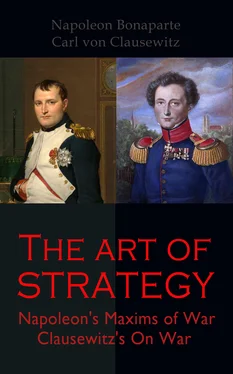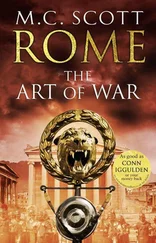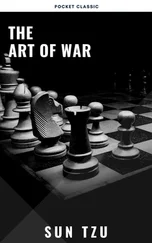The cavalry, also, which depends on the infantry for succor, is disconcerted the moment a brisk forward movement carries them out of sight of their supports. Marshal Turenne, and the generals of his time, sometimes employed this order of formation; but that does not, in my opinion, justify a modern author for recommending it in an essay, entitled “Considerations sur l’Art de la Guerre.” In fact, this formation has long been abandoned; and, since the introduction of light artillery, it appears to me almost ridiculous to propose it.
Table of Contents
Charges of cavalry are equally useful at the beginning, the middle, and the end of a battle. They should be made always, if possible, on the flanks of the infantry, especially when the latter is engaged in front.
The Archduke Charles, in speaking of cavalry, recommends that it should be brought in mass upon a decisive point, when the moment for employing it arrives; that is to say, when it can attack with a certainty of success. As the rapidity of its movement enables cavalry to act along the whole line in the same day, the general who commands it should keep it together as much as possible, and avoid dividing it into many detachments. When the nature of the ground admits of cavalry being employed on all points of the line, it is desirable to form it in column behind the infantry, and in a position whence it may be easily directed wherever it is required. If cavalry is intended to cover a position, it should be placed sufficiently in the rear to meet at full speed any advance of troops coming to attack that position. If it is destined to cover the flank of the infantry, it should, for the same reason, be placed directly behind it. As the object of cavalry is purely offensive, it should be a rule to form it at such a distance only from the point of collision as to enable it to acquire its utmost impulse, and arrive at the top of its speed into action. With respect to the cavalry reserve, this should only be employed at the end of a battle, either to render the success more decisive, or to cover the retreat. Napoleon remarks that, at the battle of Waterloo, the cavalry of the guard which composed the reserve, was engaged against his orders. He complains of having been deprived from five o’clock of the use of this reserve, which, when well employed, had so often insured him the victory.
Table of Contents
It is the business of cavalry to follow up the victory, and to prevent the beaten enemy from rallying.
Victor or vanquished, it is of the greatest importance to have a body of cavalry in reserve, either to take advantage of victory, or to secure a retreat. The most decisive battles lose half their value to the conqueror, when the want of cavalry prevents him from following up his success, and depriving the enemy of the power of rallying.
When a retiring army is pursued, it is more especially upon the flanks that the weight of cavalry should fall, if you are strong enough in that arm to cut off his retreat.
Table of Contents
Artillery is more essential to cavalry than to infantry, because cavalry has no fire for its defence, but depends upon the sabre. It is to remedy this deficiency that recourse has been had to horse-artillery. Cavalry, therefore, should never be without cannon, whether when attacking, rallying, or in position.
Horse-artillery is an invention of Frederick. Austria lost no time in introducing it into her armies, although in an imperfect degree. It was only in 1792 that this arm was adopted in France, where it was brought rapidly to its present perfection.
The services of this arm during the wars of the Revolution were immense. It may be said to have changed to a certain extent the character of tactics, because its facility of movement enables it to bear with rapidity on every point where artillery can be employed with success. Napoleon has remarked in his memoirs that a flanking battery which strikes and rakes the enemy obliquely, is capable of deciding a victory in itself. To this we may add that, independent of the advantages which cavalry derives from horse-artillery in securing its flanks, and in opening the way for a successful charge by the destructiveness of its fire, it is desirable that these two arms should never be separated, but ready at all times to seize upon points where it may be necessary to employ cannon. On these occasions, the cavalry masks the march of the artillery, protects its establishment in position, and covers it from the attack of the enemy, until it is ready to open its fire.
Table of Contents
In march, or in position, the greater part of the artillery should be with the divisions of infantry and cavalry. The rest should be in reserve. Each gun should have with it three hundred rounds, without including the limber. This is about the complement for two battles.
The better infantry is, the more important it is to support it by artillery, with a view to its preservation.
It is essential, also, that the batteries attached to divisions should march in the front, because this has a strong influence on the morale of the soldier. He attacks always with confidence when he sees the flanks of the column well covered with cannon.
The artillery reserve should be kept for a decisive moment, and then employed in full force, for it will be difficult for the enemy at such a time to presume to attack it.
There is scarcely an instance of a battery of sixty pieces of cannon having been carried by a charge of infantry or cavalry, unless where it was entirely without support, or in a position to be easily turned.
Table of Contents
Artillery should always be placed in the most advantageous positions, and as far in front of the line of cavalry and infantry as possible, without compromising the safety of the guns.
Field batteries should command the whole country round from the level of the platform. They should on no account be masked on the right and left, but have free range in every direction.
The battery of eighteen pieces of cannon, which covered the centre of the Russian army at the battle of La Moskwa (Borodino), may be cited as an example.
Its position, upon a circular height which commanded the field in every direction, added so powerfully to its effect, that its fire alone sufficed, for a considerable time, to paralyze the vigorous attack made by the French with their right. Although twice broken, the left of the Russian army closed to this battery, as to a pivot, and twice recovered its former position. After repeated attacks, conducted with a rare intrepidity, the battery was at length carried by the French, but not till they had lost the élite of their army, and with it the Generals Caulincourt and Montbrun. Its capture decided the retreat of the Russian left.
I might advert likewise to another instance, in the campaign of 1809, and to the terrible effect produced by the hundred pieces of cannon of the Guard which General Lauriston directed, at the battle of Wagram, against the right of the Austrian army.
Table of Contents
A General should never put his army into cantonments, when he has the means of collecting supplies of forage and provisions, and of thus providing for the wants of the soldier in the field.
One great advantage which results from having an army in camp is, that it is easier to direct its spirit and maintain its discipline there. The soldier in cantonments abandons himself to repose; he ends by finding a pleasure in idleness, and in fearing to return to the field. The reverse takes place in a camp. There, a feeling of ennui , and a severer discipline, make him anxious for the opening of the campaign, to interrupt the monotony of the service and relieve it with the chances and variety of war. Besides, an army in camp is much more secure from a surprise than in cantonments—the defect of which usually consists in their occupying too great an extent of ground. When an army is obliged to go into quarters, the Marquis de Feuquière recommends a camp to be selected in front of the line, where the troops can be frequently assembled—sometimes suddenly, in order to exercise their vigilance, or for the sole purpose of bringing the different corps together.
Читать дальше












